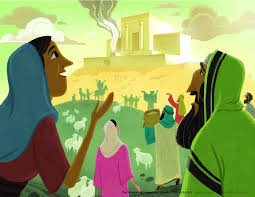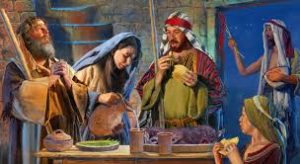The Completion
and Dedication of the Temple
Ezra 6:13-22 and Zechariah 6:9-13
The completion and dedication of the Temple DIG: Who oversees the work on the Temple (6:13-18)? Who else is involved? How so? Whose authority seems to prevail? Who gets credit without being on the scene? How does this Temple dedication service compare with the previous one (6:16-18, also see Second Chronicles 7:1-10)? How do you account for this rather poor showing? Priest, Levites, the exiles, and converts all celebrate the Passover (6:19-22). What must each do participate (see Exodus 12:43-50; Numbers 9:1-14).
REFLECT: What half-done project does God want you to “carry out with all diligence?” Why not get on with it? How does an outsider get to celebrate the sacraments in your messianic synagogue or church? Are you more open, or less open than early Judaism?
April 515 BC During the ministry of Zerubbabel (to see link click Ag – The First Return).
Compiled by the Chronicler from the Ezra memoirs
(see Ac – Ezra-Nehemiah from a Jewish Perspective: The Ezra Memoirs).
Ezra 4:8 to 6:18 is written in Aramaic, the language the Persians used in official documents (much like the Roman Empire used Greek). With the celebration of the Passover, the language appropriately returns to Hebrew.

The completion and dedication of the Temple: Then, because of the decree King Darius had sent, Tattenai, governor of Trans-Euphrates, and Shethar-Bozenai and their associates carried it out with all diligence (Ezra 6:13). The expression with all diligence is a key word in these chapters, expressing the way the builders went about their work (Ezra 5:8), then the urgency of the king’s decree (Ezra 6:8 and 12), and finally the thorough cooperation of the civil government. Tattenai, as provincial governor, had acted responsibly throughout, in making the inquiry, waiting for confirmation (Ezra 5:5), and following through on the decree. He was no Sanballat (Nehemiah 3:33).117
So the elders of the Jews continued to build and prosper under the preaching of Haggai the prophet and Zechariah, a descendant of Iddo. They finished building the temple according to the command of the God of Isra’el and the decrees of Cyrus, Darius and Artaxerxes, kings of Persia (Ezra 6:14). The most powerful word on earth at that time was the decree of a Persian king, but silently and mysteriously these kings were being directed by an even more powerful divine word. Workers, prophets, kings and Ha’Shem were all involved. Artakh’shasta had nothing to do with building the Temple; apparently his name was added to round out the account, for he had decreed the building of Jerusalem’s walls (Nehemiah 2:1 and 8). He also helped provide for sacrifices at the Temple (Ezra 7:12-17).
The Temple was completed on the third day of the month Adar (the closing month of the Jewish calendar year, corresponding to February-March), in the sixth year of the reign of King Darius (Ezra 6:15). Since the work resumed in the sixth month of Darius’ second year (Haggai 1:15) it took nearly four and a half years. The foundations had been laid some twenty-one years earlier in 536 BC (to see link click Ar – The Start of the Rebuilding the Temple). This was seventy years after the Temple had been destroyed in 586 BC.
Then the people of Isra’el – the priests, the Levites and the rest of the exiles—celebrated the dedication of the house of God with joy (Ezra 6:16). Celebrations have always been vital for the people of God. They are occasions for fellowship, of worship, of glorifying ADONAI. They bind the community together and enable everyone to understand the purpose and history of the community. The term translated dedication is the Hebrew word hanukkah, the name of the Jewish holiday that celebrates a similar rededication of the Temple after its defilement by the Seleucid King Antiochus IV (see the commentary on The Life of Christ Hj – Then Came Hanukkah at Jerusalem and It Was Winter).118
For the dedication of this house of God they offered a hundred bulls, two hundred rams, four hundred male lambs and, as a sin offering for all Isra’el, twelve male goats, one for each of the tribes of Isra’el (Ezra 6:17). The offerings were costly enough, yet dwarfed by 22,000 oxen and 120,000 sheep of Solomon’s dedication day (First Kings 8:63). Twelve male goats had been similarly sacrificed as a sin-offering when the altar in the wilderness was dedicated (Numbers 7:87). This precedent of old was evidently followed on the present occasion. The sin offering made in the wilderness was full of deep religious sorrow. The remnant who had returned made a solemn confession of sin in the name of the whole scattered and despised race. They acknowledged the essential unity of Isra’el’s tribes in the consequences of sin, in the possibilities of restoration, and in the renewed dedication to the service of ADONAI.
And they installed the priests in their divisions and the Levites in their groups for the service of God at Jerusalem (see the commentary on the Life of David Ev – The Divisions of Priests), according to what is written in the Book of Moses each officiating for a week in turn (Ezra 6:18). The exile had taught them that God’s people suffer when they do not live up to their covenantal obligations.

The Passover: On the fourteenth day of the first month, the exiles celebrated the Passover for the first time in seventy years (Ezra 6:19). Rather appropriately, the language of the story now reverts to Hebrew, only the returning to Aramaic for the letter of Artakh’shasta (see Bi – King Artakh’shasta’s Letter to Ezra). The Temple had been completed on the twelfth month of Adar, and fittingly, Pesach was re-inaugurated the very next month. Whenever the celebration of Pesach is recorded in the TaNaKh, it is in connection with an important landmark in national life (Numbers 9:5; Joshua 5:10; Second Kings 23:21; Second Chronicles 30:1 and 35:1).
The priests and Levites had purified themselves by a mikveh, a ritual washing with water (Exodus 29:4; Numbers 8:7), and were all ceremonially clean. The author of Chronicles emphasized the need for this purification. In fact, Hezekiah’s great Passover celebration was delayed a month because there were not enough ceremonially pure priests (Second Chronicles 30:2-3). The Levites slaughtered the Passover lamb for all the exiles, for their relatives the priests and for themselves. So the Israelites who had returned from the exile ate it, together with all who had separated themselves from the unclean practices of their Gentile neighbors in order to seek the Lord, the God of Isra’el (Ezra 6:20-21). The Jews of the exile were not bitterly exclusive. This second group was probably the Jews who had remained in the Land after the exile and had defiled themselves with Gentile practices, and then repenting, thereby separating themselves. The convert found an open door, as Rahab and Ruth had found out.
This decision involved two basic decisions, one negative and one positive – similar to what believers must make today. First, they separated themselves from the unclean practices of their Gentile neighbors. In order to follow Messiah, we must reject the immoral life-style of the world. Biblical faith is an ethical faith. Ha’Shem is holy, and He demands that His children be holy. The second decision is positive: to seek the Lord, the God of Isra’el. This means turning to Him, seeking communion with Him, and seeking to do His will. Time after time the prophets condemned the people and announced God’s judgment because they did not seek His face (Isaiah 9:13, 31:1; Hosea 7:10; Zephaniah 1:6; Jeremiah 10:21).119
After Pesach, they celebrated the Festival of Unleavened Bread for seven days with joy, because the Lord had filled them with joy by changing the attitude of the king of Assyria (the Persian Empire included what was once Assyria) so that he assisted them in the work with materials and money on the house of God, the God of Isra’el (Ezra 6:22). Once this eight-day celebration was over, nine-hundred years after the Egyptian Passover (see the commentary on Exodus Bv – The Egyptian Passover), it signaled the end of the exile for the Righteous of the TaNaKh and the nation was once again back in true fellowship with YHVH. Since the Levitical system of worship had been restored, it was important for the people atone for their sins on the bronze altar (see the commentary on Exodus Fa – Build an Altar of Acacia Wood Overlaid with Bronze). The people had seen firsthand how Ha’Shem worked through history, for He had caused pagan kings to issue decrees that let them return to the Promised Land (much as He had caused Egypt’s Pharaoh to release Isra’el). The original readers of Ezra-Nehemiah would rejoice in that fact and would be encouraged to participate fully in Temple worship, which had been reestablished at such great cost.120
In Zechariah 6:9-11, following the record of the eight night visions, the prophet depicts the coming of men from Babylon, Jews who had not returned with the others in 538 BC. They bring with them with silver and gold, which is fashioned into a crown fit for a king to wear. Instead of Zerubbabel (the heir apparent), Jeshua (the high priest) receives the crown. Crowning a political figure, such a Zerubbabel, would be viewed as an act of rebellion; crowning a high priest would have appeared odd, to say the least. Not only that, but the crown was placed in the completed Temple as though waiting for the true King-Priest to appear. Even more significant are the words that accompany this account; ADONAI-Tzva’ot says to Jeshua, “Behold, a man whose Name is the Branch will branch out from His place and build the Temple of ADONAI. He will bear splendor and sit and rule on His throne. Thus, He will be a cohen on His throne. So a counsel of shalom will be between [the offices of King and Priest]” (Zechariah 6:12-13).121
ADONAI told Jeshua that he would represent or typify the Branch who will rebuild the Millennial Temple (see the commentary on Jeremiah Gs – God Shows a Vision of the Millennial Temple). The crowning had a far eschatological significance pointing to Messiah as the King-Priest, like Melchizedek centuries earlier (see the commentary on Hebrews Be – Melchizedek Was a Type of Christ). The title Branch is a messianic title (Zechariah 3:8).
Since the promise to rebuild the Temple in Zechariah’s day was given to Zerubbabel, any role Jeshua would have had was apparently minor. So the Second Temple stood as a sign of the coming Branch-Messiah, who would build the true temple of God.122
So The temple was completed (Ezra 6:15), but in another sense, the work had barely begun. A new day was coming, a day of the Lord’s power and might. A day when the shadow would give way to the reality because the real Temple is where Jesus is for He is the Temple, the place where YHVH and mankind meet, the place of reconciliation and of the Kingly rule. Yeshua is in heaven, but He makes Himself present among us by His Ruach Ha’Kodesh. Where the Spirit is, there the gospel is being preached and the people of God, both Jews and Gentiles (Ephesians 2:14), are brought into fellowship with ADONAI at the true Temple. The Spirit is not confined to one physical or geographical location, which is why modern pilgrimages to “the Holy Land” are a misnomer. The only biblical pilgrimage to the Holy Land is to go to Jesus Christ by faith, for He represents for us the real Mount Zion. The nations are coming to the Temple wherever the gospel is preached and applied to human hearts by the Spirit of Yeshua.123



Leave A Comment